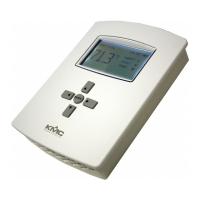FlexStat (General) 16 Application Guide, Rev L
DEMANDCONTROLVENT
VENTOVERRIDE:
MODE:STARTUP
OFF
NOTE: See the FlexStat Operation Guide for more information
about conguration and use of DCV as well as other energy-
saving features such as occupancy standby (with the motion
sensor). See also the sequences of operation starting with DCV
(Demand Controlled Ventilation)—General Information on
page 35. See also the relevant installation guide for the FlexStat
or sensor.
Too lile ventilation may make us feel lethargic and cause us to breathe
in pollutants (e.g., VOCs, radon, cigaree smoke) that accumulate in
inside air and are potentially hazardous to our health. Too much ventila-
tion, on the other hand, is ne for people but wastes energy in condition-
ing the extra, unnecessary outside air. HVAC systems in many com-
mercial buildings are designed for a specic number of occupants, but
typical occupation levels at any given time are usually lower than these
“worst case” design levels. Hence, such building spaces receive more
ventilation than necessary and energy is wasted. Just the right amount
of ventilation is the ideal, sustainable balance between protecting indoor
air quality and health of occupants versus minimizing energy costs.
The most eective means of aaining a “Goldilocks” zone for ventila-
tion is by using CO
2
sensors and demand control ventilation (DCV)
sequences in a Building Automation System. (DCV is also sometimes
called demand controlled ventilation.) DCV adjusts the amount of
outside air ventilation to keep CO
2
levels measured by inside sensors at
or below a specied maximum (usually 700 ppm of CO
2
above that of
outside air, which is typically around 400 ppm). Instead of controlling
the ventilation based on preset worst-case scenarios, DCV continuously
controls ventilation based on real-time actual needs. This produces
substantial energy and cost savings...especially for facilities with highly
CO
2
Sensors and DCV
variable occupancy, such as meeting rooms, classrooms, theaters, gyms,
retail stores, and hotels.
With a built-in CO
2
sensor, the BAC-13xxxx series FlexStat uses patented
self-calibration techniques designed to be used in applications where
concentrations will drop to outside ambient conditions (approximately
400 ppm) at least three times in a 14 day period, typically during unoc-
cupied periods. (This series has been certied to comply with CA Title
24, Section 121(c), as well as sub-paragraph 4.F that species accuracy
will be maintained within tolerance for a minimum of 5 years without
recalibration.)
However, in zones that may contain people 24/7, the inside CO
2
levels
will not drop to outside levels consistently. For zones with continuous
occupancy, the BAC-14xxxx series has a dual channel sensor. In that sen-
sor, a CO
2
channel measures gas concentration, and a reference channel
measures the sensor signal intensity. Self-calibrations are performed
approximately every 24 hours using the reference channel.
Although BAC-12xxxx FlexStats do not have a built-in CO
2
sensor, they
still have DCV control sequences available. When DCV is enabled in the
Damper Setup menu of these models, IN9 is assumed to be connected
to an external SAE-10xx CO
2
(duct or space) sensor. 0–5 VDC on that
input will map to 0–2000 ppm (using the defaults). The output of the
connected SAE-10xx must also be congured to match the FlexStat’s
input, and the FlexStat’s IN9 pull-up resistor must be set for 0–12 VDC!
BAC-13xxxx/14xxxx FlexStats also have the external sensor option, and
if used, the highest of the two readings (internal vs. external) will be
used to control DCV sequences. The CO
2
ppm display (if enabled) also
shows the highest of the two levels.
“Standard”
BAC-1xxxx or
BAC-12xxxx
FlexStat
without CO
2
Sensor
BAC-13xxxx
and BAC-14xxxx
FlexStat with
CO
2
Sensor
DAMPERSETUP
ECON:
DCV:ADVANCED
DCVSETUP
MINPOSITION:0%
CNTRL(0–100%):2–10V
ECONENBLETEMP:55°F
LOWLIMITALARM:45°F
MODULATING
DCVSETUP
VENTMODE:STARTUP
DCVDAMPERSETUP
CO2MAX(PPM):1000
CO2BASE(PPM):400
OAAREA:2%
OAFULL:5%
OAMAX:40%

